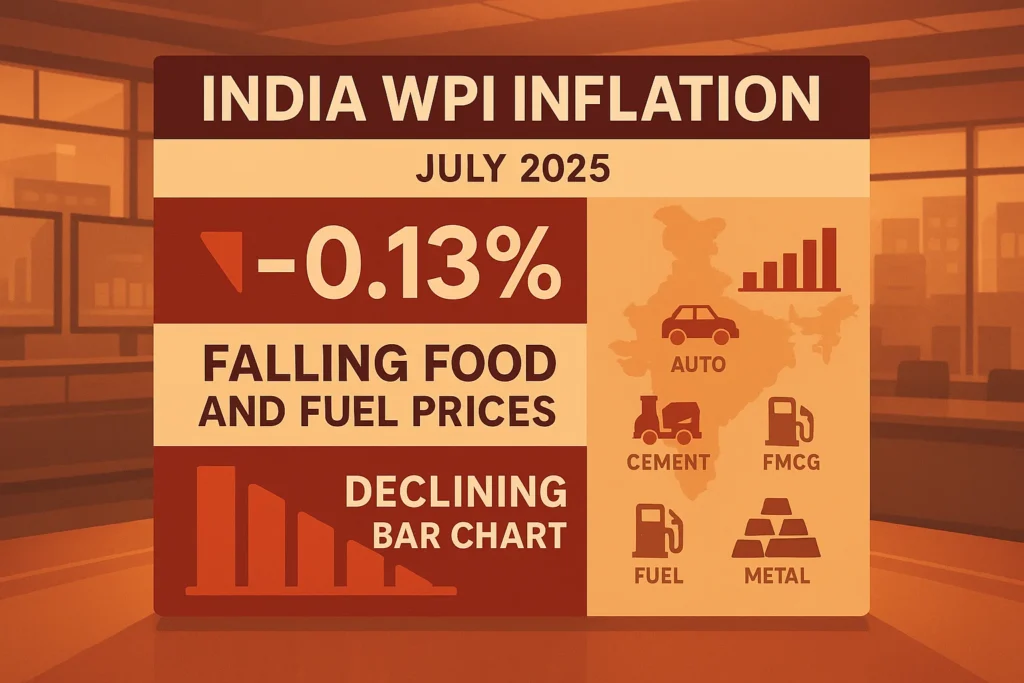Introduction: A Surprise from the Wholesale Price Index
The WPI Inflation July 2025 data released on Monday, July 14, 2025, delivered an unexpected jolt to market observers and policy watchers. India’s Wholesale Price Index (WPI) inflation fell to -0.13% year-on-year in June, slipping below zero for the first time in several months. This decline comes even as consumer inflation (CPI) remained elevated, highlighting a widening gap between wholesale and retail pricing dynamics.
This negative WPI inflation July 2025 print—also known as wholesale deflation—is a key signal for businesses, investors, and policymakers. It indicates falling prices at the production or factory gate level, which can ripple across sectors and influence monetary policy, corporate margins, and equity valuations.
In this blog, we’ll unpack what this WPI data means, how it affects different sectors, and which stocks could be poised to benefit or face headwinds in the short to medium term.
WPI Inflation July 2025: The Data at a Glance
| Metric | Actual (June 2025) | Forecast |
|---|---|---|
| WPI Inflation (YoY) | -0.13% | 0.52% |
| WPI Food Index (YoY) | -0.26% | 1.72% |
| WPI Fuel Inflation (YoY) | -2.65% | -2.27% |
| WPI Manufacturing (YoY) | 1.97% | 2.04% |
This marks a steep divergence from retail (CPI) inflation, which continues to hover above the 4.5% mark. Falling WPI is largely driven by a sharp drop in fuel and food prices—an outcome of global commodity correction and improved domestic supply.
What Does a Negative WPI Mean for the Economy?
WPI reflects price trends at the wholesale level, which influence producers, manufacturers, and intermediaries. A drop in WPI inflation, especially when it turns negative, signals weak pricing power for businesses. But its implications are nuanced:
- Positive for Input Cost Pressure: Companies may benefit from cheaper raw materials and energy inputs, improving margins.
- Risk of Demand Weakness: Persistent WPI deflation may indicate soft underlying demand, particularly in industrial and commodity-linked segments.
- RBI Policy Signal: Although RBI focuses on CPI for rate decisions, a negative WPI adds pressure to consider easing monetary policy if growth slows.
Sectoral Impact of WPI Inflation July 2025
Let’s break down how different sectors are likely to be impacted by this development:
1. Auto Sector: Margins May Accelerate
The auto sector is a key beneficiary of lower WPI inflation, particularly due to falling commodity and fuel prices.
- Fuel costs (down 2.65% YoY) reduce transportation and logistics overheads.
- Steel and rubber price moderation improves gross margins for auto OEMs and ancillary suppliers.
Stocks to Watch:
- Tata Motors, Maruti Suzuki, Balkrishna Industries, and Motherson Sumi may gain from improved cost dynamics.
- Two-wheeler makers like Hero MotoCorp and TVS Motor could also see tailwinds in rural demand if input savings translate to lower product prices.
2. FMCG & Consumer Staples: Mixed Bag
WPI Food Index turned negative (-0.26% YoY), indicating deflation in wholesale food prices. While this is positive for FMCG companies’ input costs, it could also hint at sluggish rural demand.
- Cheaper food grains, edible oils, and milk prices may reduce raw material inflation for packaged food companies.
- However, falling food prices could compress rural income, which might impact discretionary consumption.
Stocks to Watch:
- Hindustan Unilever, ITC, and Nestle India may see margin gains.
- Rural-facing brands like Emami and Dabur need careful monitoring on the demand front.
3. Cement & Infra: A Big Win on Input Cost
Cement manufacturers stand to benefit from lower fuel and logistics costs—a major portion of their operating expenses.
- Diesel, pet coke, and freight costs are all linked to WPI Fuel Index.
- Soft WPI could also signal easing construction input prices (steel, bitumen, aggregates).
Stocks to Watch:
- UltraTech Cement, Shree Cement, and Ambuja Cements could report better operating margins.
- Infra EPC players like L&T and PNC Infratech will benefit from cost moderation in raw materials.
4. Oil & Gas: Mixed Signals
The sharp fall in WPI Fuel Index (-2.65%) reflects lower crude oil and fuel product prices, which has implications for oil-linked businesses.
- Refining margins may come under pressure if product spreads narrow.
- OMCs like IOCL, BPCL, HPCL benefit from lower under-recoveries and better marketing margins.
- CGD players like MGL, IGL, and Gujarat Gas benefit from lower LNG spot prices translating into lower input costs.
Stocks to Watch:
- Positive: Indraprastha Gas, Mahanagar Gas, Gujarat Gas
- Cautious: Reliance Industries, ONGC, HPCL
5. Metals & Mining: A Key Watch
While WPI Manufacturing remains positive at 1.97%, falling fuel and input costs suggest declining realisation pressures for metal producers.
- Global commodity softening and China-related concerns may further pressure prices.
- Cost benefits help only if volumes remain stable.
Stocks to Watch:
- Tata Steel, JSW Steel, Vedanta, Hindalco could be volatile.
- Watch for any global metal price cues post this WPI print.
6. Banking & NBFCs: Inflation Clarity Helps, But Credit Growth Matters
While WPI is not directly tied to credit quality or loan growth, lower inflation reduces RBI’s urgency to hike rates further, which helps financial stocks.
- Banks may benefit from stable policy rates and improving credit demand.
- NBFCs, particularly in rural areas, may see margin relief if their funding costs stay steady and end-user input prices drop.
Stocks to Watch:
- Positive: HDFC Bank, ICICI Bank, Cholamandalam Investment, M&M Financial
RBI Monetary Policy: Will WPI Deflation Influence the Central Bank?
Though the RBI’s primary focus is CPI inflation, a sustained decline in WPI cannot be ignored. Wholesale price trends often lead consumer price trends over time.
If deflation in WPI persists for another 2–3 months:
- RBI may consider a dovish policy tone.
- This will be particularly true if CPI falls below 4% and IIP growth moderates.
- Rate-sensitive sectors (real estate, auto, infra) would react positively to any indication of easing.
How Should Investors Play This Data?
A single data point should not dictate your entire strategy, but it can certainly inform tactical positioning:
Bullish Sectors:
- Autos
- Cement & Infra
- CGDs and Gas Distribution
- FMCG (margin tailwinds)
Caution Zones:
- Upstream Oil & Gas
- Global commodity-linked metals
- Discretionary FMCG with rural dependency
Themes to Track:
- Margin expansion stories
- Debt-free, consumption-facing midcaps
- Exporters if global commodity softness continues
Conclusion: A Market Friendly Surprise, But Eyes on Demand
The negative WPI inflation July 2025 data is a welcome surprise for margin-sensitive sectors. But it also raises questions about underlying demand and pricing power, especially in B2B manufacturing and rural consumption.
With WPI below zero, RBI gets more elbow room, and corporates get cost relief. However, if this turns into deflationary pressure, it could hurt revenue growth.
For now, investors can celebrate margin gains but should remain selective—focusing on companies with volume growth, clean balance sheets, and strong consumer pull.
FAQs on WPI Inflation July 2025
1. What is WPI inflation and how is it different from CPI inflation?
WPI (Wholesale Price Index) inflation measures price changes at the wholesale or producer level, while CPI (Consumer Price Index) tracks price changes at the retail level for consumers. WPI reflects input costs for businesses, and CPI reflects end-prices paid by consumers.
2. Why did WPI inflation turn negative in July 2025?
WPI inflation turned negative at -0.13% due to a sharp drop in fuel (-2.65%) and food prices (-0.26%), driven by global commodity softening and improved domestic supply conditions.
3. Is negative WPI inflation good or bad?
It depends. Negative WPI can lower input costs for businesses, boosting margins. However, if it reflects weak demand, it could signal economic slowdown or deflationary risks.
4. How does WPI inflation affect the stock market?
Sectors like auto, cement, FMCG, and gas distribution benefit as their input costs drop. But metals, upstream oil & gas, and rural consumption-linked firms may face headwinds.
5. Will this data influence RBI’s interest rate decisions?
RBI focuses more on CPI inflation. However, a persistently low or negative WPI adds indirect pressure to ease policy if growth slows and retail inflation softens.
6. Which sectors benefit the most from lower WPI inflation?
Sectors that rely heavily on raw materials and logistics—like automobiles, cement, FMCG, and city gas distribution (CGD)—typically see the biggest gains due to margin expansion.
7. How should investors use WPI data in portfolio decisions?
WPI trends offer insights into cost dynamics and sector margins. Investors can look for companies with improving operating margins, strong sales, and low debt to gain from such inflation shifts.
Related Articles:
India’s Corporate Bond Market: Growth, Gaps & the Retail Investor Roadblock
Medical Inflation: Stocks That Gain & Lose
How Inflation Affects the Stock Market: Why April’s Cooldown Is a Gamechanger
More Articles
India’s Future Outlook: Growth vs Inflation
Foreign Bonds Investment: A Complete Guide to Global Debt Markets
How RBI’s Gold Loan LTV Hike Impacts Small Borrowers and NBFCs






